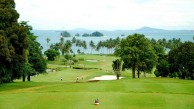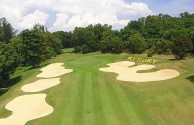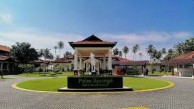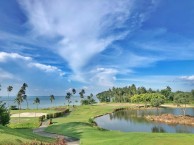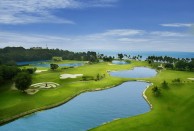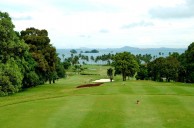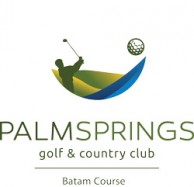
Palm Springs Golf & Country Club
27 holes par 72/36 (6143/2982 meters)
Palm Springs Golf & Country Club Information
| Designer: | Nelson & Hayworth |
| Holes / Par / Yardage: | 27 holes par 72/36 (6143/2982 meters) |
| Established: | 1995 |
| Location: | 35 minutes from Singapore |
| Distance: | 5 minutes from Nongspura Ferry Terminal |
| Closed on: | Open everyday |
| Max. golfers per group: | Weekday: 4 Weekend: 4 |
| Golf Cart: | Included |
| Golf Set: | USD 28 |
| Golf Shoes: | USD 20 |
| Umbrella: | USD 10 |
| Driving Range: | Yes |
| Facilities: | Accommodation, Fitness, Golf Academy, Golf School, Massage, Restaurants, Riding, Sauna, Shooting, Snooker, Spa, Squash, Swimming Pool, Tennis |
(excellent course with elevation changes and scenic views)
Palm Springs Golf & Country Club is the closest Batam golf course to Singapore and part of a large 224-hectare property complex in the corner of the island. When arriving at Nongsapura Ferry Terminal, it’s a 5-minute ride to the clubhouse which overlooks a very pretty palm-fringed beach — situated with spectacular views of Nongsa beach with Singapore skyscrapers in the background. The 27-hole hole golf course designed by Larry Nelson of Nelson & Hayworth and IMG.
The first nine holes were opened in 1989 when it was known as Talvas Golf & Country Club. An additional 18-holes were completed in 1995 when the name changed to Palm Springs Golf & Country Club. In 2002, the Palm Course was redeveloped, making it one of the most challenging 9-holes in South East Asia. Unfortunately, these nine are scheduled to be demolished and make way for housing in the next few years.
With three excellent 9-hole layouts – Palm Course, Resort Course, and Island Course and each of these layouts offer a very different challenge. Whichever combination of nines played will ensure a great day of golf at Palm Springs.
Integrating elevation, contours, and scenic views are the best points about Palm Springs. The Island Course and Resort Course are better for beginners, while the Palm Course is best suited to low handicappers.
The Palm Course incorporates holes along the beach together with higher elevation holes that play through virgin rainforest. The first four holes are as challenging as they come. A par on the opening par-5 is a good sign for the rest of the nine. Most of the greens are severely sloped, so staying below the hole is a must.
The Island Course plays on a ridge through the jungle with natural features such as mangrove vegetation. Some of the holes have smallish landing areas, and it might be better to aim for the waste bunkers on one side of the fairways than to be OB in the mangrove swamps.
The Resort Course benefits from varied topography with hills rising steeply to more than 35 meters above the level. In spite of the elevation change, the Resort Course is the easiest of the three courses at Palm Springs. Fairways are generous, and bunkers are off to the sides. The only tricky part of the Resort Course is the green slopes. They all follow the hills, so be sure to peek at the angle before committing to each putt. Then a one or two putts will be assured.
Both professional male and female caddies handle the clubs and provide players assistance throughout the round. They are courteous and can answer questions regarding course layout and shot placement, all which help improve golf scores. The clubhouse is rather old as are the other facilities. However, upgrading of infrastructure continues, so check any construction status before heading out for a round at Palm Springs.



